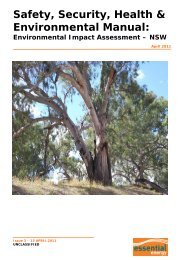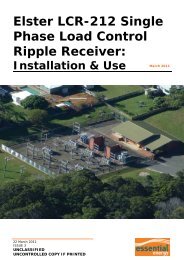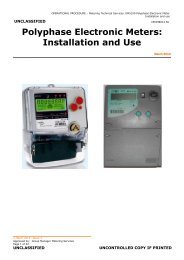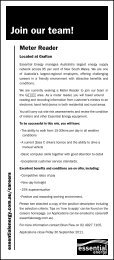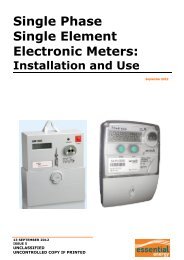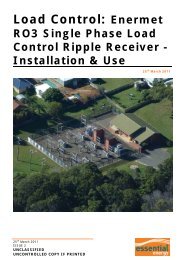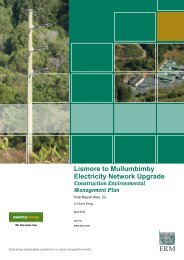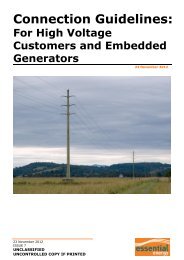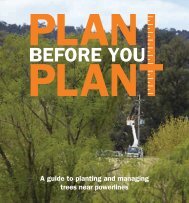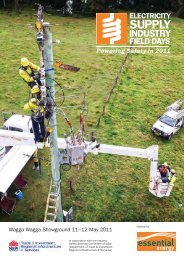Viticulture Electrical Safety Fact Sheet - Essential Energy
Viticulture Electrical Safety Fact Sheet - Essential Energy
Viticulture Electrical Safety Fact Sheet - Essential Energy
You also want an ePaper? Increase the reach of your titles
YUMPU automatically turns print PDFs into web optimized ePapers that Google loves.
ELECTRICITY AND VITICULTURE<br />
What should I do before commencing any work on a<br />
property?<br />
- Know the location of powerlines on the property and<br />
their proximity to your work<br />
- Provide workers with accurate, up-to-date<br />
maps/diagrams showing the location of powerlines<br />
on the property, also indicating safe traffic paths to<br />
eliminate the possibility of powerline contact<br />
- Complete a risk assessment so as to identify and put<br />
in place the appropriate control measures to prevent<br />
any hazards (including work practices and<br />
procedures) which may have the potential to harm<br />
the health or safety of a person. This should be<br />
completed for each paddock and piece of machinery<br />
to be used<br />
- Install visual markers in any areas where electrical<br />
hazards are identified prior to commencing work, as<br />
vision can be obstructed due to blind spots in<br />
machinery<br />
- Carefully monitor weather conditions - powerlines can<br />
sway in winds, sag as temperature increases and are<br />
difficult to see at dawn and dusk<br />
- Ensure operators are aware of the height and reach<br />
of their machinery in both stowed and working<br />
positions to ensure that minimum approach distance<br />
to powerlines are maintained (see <strong>Essential</strong> <strong>Energy</strong>’s<br />
fact sheet ‘Work near overhead powerlines’ for<br />
minimum approach distances)<br />
- Machinery measuring over 4.6 metres has a high risk<br />
of contacting overhead powerlines and should be<br />
closely monitored to ensure required minimum<br />
approach distances are maintained.<br />
Safe work habits<br />
- Ensure required minimum approach distances are<br />
maintained (the amount of space required to be kept<br />
between machinery and anything held by a person<br />
and the powerlines in order to prevent electricity<br />
arcing to you or the machinery)<br />
- Assign a competent safety observer to each work<br />
team to guide machinery movements near overhead<br />
powerlines, in order to warn the person/operator of<br />
unsafe conditions and ensure that minimum safe<br />
approach distances are maintained<br />
- Lower all machinery to the transport position when<br />
relocating every time<br />
- When applying netting to vines ensure minimum<br />
approach distances between machinery and<br />
powerlines are maintained.<br />
What are the safe approach distances when working<br />
near powerlines?<br />
Workers and their equipment should not approach<br />
overhead powerlines any closer than the following, when<br />
machinery is being operated:<br />
Powerlines<br />
with voltages<br />
up to<br />
132 000 volts<br />
Between<br />
132 000 and<br />
330 000 volts<br />
More than<br />
330 000 volts<br />
e.g. low voltage and high<br />
voltage distribution and<br />
subtransmission lines, usually<br />
on poles<br />
e.g. subtransmission and<br />
transmission lines on either<br />
poles or towers<br />
e.g. transmission lines usually<br />
on towers<br />
3m<br />
6m<br />
8m<br />
Minimum approach distances when working near powerlines
What do I need to know about electrical safety inside<br />
the winery?<br />
- There is increased possibility of receiving electric<br />
shock as a result of using electricity when working in<br />
a damp situation<br />
- Ensure you use electrical equipment and fittings<br />
which are intended for use when working in wet or<br />
damp locations<br />
- All electricity supplies at mains voltage are required<br />
by NSW law to meet the requirements of the SAA<br />
Wiring Rules AS3000<br />
- Avoid using temporary extension leads where<br />
possible.<br />
For more information<br />
ELECTRICAL HAZARD AWARENESS<br />
<strong>Essential</strong> <strong>Energy</strong>’s Public <strong>Safety</strong> team is available to<br />
facilitate <strong>Electrical</strong> Awareness sessions and discuss any<br />
questions relating to electrical safety.<br />
For more information on electrical safety please call<br />
<strong>Essential</strong> <strong>Energy</strong>:<br />
General enquiries 13 23 91<br />
Supply interruptions 13 20 80<br />
Follow us<br />
or visit essentialenergy.com.au/safety<br />
What else can I do to make my property ‘power<br />
safe’?<br />
- <strong>Safety</strong> Switches, also<br />
known as residual<br />
current devices (RCDs)<br />
or earth leakage circuit<br />
breakers (ELCB) should<br />
be installed by qualified<br />
personnel on all circuits<br />
in the winery and<br />
workshop areas<br />
- <strong>Electrical</strong> equipment and<br />
electrical leads should<br />
be regularly inspected and tested in accordance with<br />
the requirements of Australian Standard AS3760<br />
- Ensure maintenance of machinery and<br />
loading/unloading activities are carried out well away<br />
from powerlines<br />
- Use extra low voltage (max 32 V ac of 115V dc)<br />
equipment where possible<br />
- Contact <strong>Essential</strong> <strong>Energy</strong> about marking powerlines<br />
and power poles on your property for improved<br />
visibility.<br />
To warn workers of the presence of overhead powerlines:<br />
Install appropriate signage at least 8 to 10 metres<br />
either side of powerlines<br />
Have visual indicators such as flag markers fitted<br />
to the powerlines (contact <strong>Essential</strong> <strong>Energy</strong>)<br />
Where possible, provide ground barriers.<br />
<strong>Essential</strong> <strong>Energy</strong> recommends you familiarise yourself<br />
with the latest WorkCover Code of Practice ‘Work near<br />
Overhead Powerlines’ which can be viewed at:<br />
www.workcover.nsw.gov.au or you can purchase a copy<br />
of the Code of Practice by contacting WorkCover on<br />
1300 799 003<br />
SAFETY FIRST:<br />
You can still be injured without directly contacting<br />
an overhead powerline, as electricity can arc<br />
across open spaces – so keep your distance!<br />
Be aware that the apparent height of powerlines<br />
will vary depending upon the angle which they are<br />
viewed<br />
Always treat all powerlines as alive even though<br />
they may appear to be dead.




